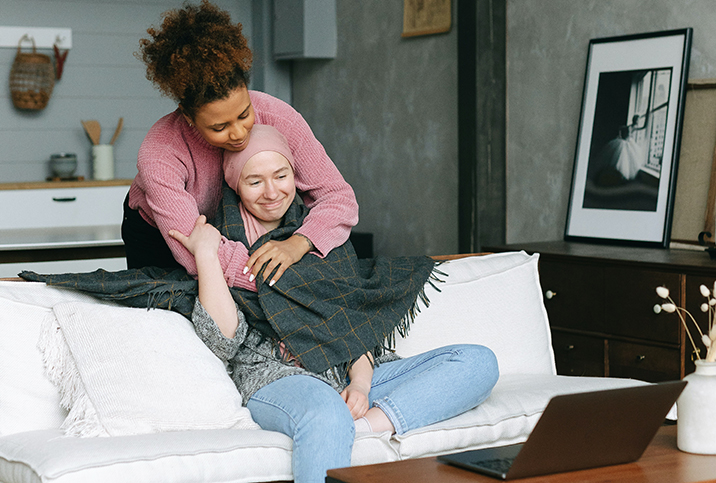Treatment of Ovarian Cancer

Ovarian cancer impacts 1 in 78 American women in their lifetime. While the disease is more deadly than other cancers—ranking fifth in cancer deaths among women and first in gynecological-cancer-related deaths—multiple treatment options are available, and medical advancements are constantly improving outcomes.
Overview of Ovarian Cancer
Ovarian cancer originates in a woman's ovaries, the small, almond-shaped organs that flank the uterus, producing ova (or eggs), progesterone and estrogen, and releasing an egg monthly in the process of ovulation.
Risk factors include being older, Black or Ashkenazi Jewish; personal or family history of breast, ovarian or colorectal cancer; certain genes (BRCA1, BRCA2, ATM, BRIP1); being overweight/obese; smoking; taking hormone replacement therapy (HRT); beginning menstruation before age 12 or starting menopause after age 55; or not having a full-term pregnancy before age 35.
Diet may also play a role: Research indicates that the consumption of high amounts of animal fat, cholesterol, dairy, meat, eggs and whole milk is associated with an increased risk of ovarian cancer, while vegetables, fruits, dietary fiber, beta-carotene and vitamin A are protective.
Symptoms can often be elusive, which is why only 15 percent of ovarian cancer cases are detected in stage I, and 60 percent are detected in stage III.
While frequently subtle or nondescript, signs to watch out for can be wide-ranging. They include abdominal pain, swelling and bloating, back or pelvic pain, pain with sex, loss of appetite (or feeling full quickly while eating), heartburn, weight loss, fatigue, urinary frequency or urgency, constipation or bowel changes, increased or irregular menstrual bleeding and abnormal vaginal discharge.
Ovarian cancer may be detected during a routine pelvic exam but is most often investigated only after a patient reports symptoms. A variety of tests, including a pelvic exam, blood test (for cancer antigen 125) and transvaginal ultrasound and biopsy, can determine the presence of cancerous cells, as well as their grade, stage and other characteristics.
Knowing what to look for can increase chances of early detection and improve prognosis. High-risk women may be recommended for additional screening and prevention measures.
If a cancer diagnosis is made, treatment options commonly begin with surgery and chemotherapy, and may also include radiation, hormone and targeted therapies. Appropriate treatment varies, depending on patient characteristics and the type and stage of cancer. A good doctor will explain all options, the pros and cons of each, and how to maximize the opportunity for successful treatment.
Surgical treatment
Surgery is commonly the first step in the treatment of ovarian cancer (in very advanced cases, chemotherapy may be recommended first). The removal of a single ovary may be recommended for very early-stage cancers, in which the cancer is localized to just one ovary and its fallopian tube.
For cancer confined to the ovaries, the removal of both may be recommended. In more advanced cases, or for women who don't wish to get pregnant in the future, surgical treatment may include the removal of both ovaries and fallopian tubes, as well as the uterus, local lymph nodes and the omentum (a layer of abdominal fatty tissue).
Women who have one ovary removed may retain the ability to get pregnant naturally. Removal of both ovaries will compromise getting pregnant naturally through intercourse, but conception may still be possible (if the uterus was not removed) through in vitro fertilization (IVF) or with donor eggs. Speak up about fertility goals early on, and ask about cryopreservation to harvest and preserve eggs.
Preoperative visits will likely be required one to two weeks before surgery and may include blood and urine tests, a chest x-ray and an ECG. You may be asked to use a certain soap, take antibiotics or stop regular medications or supplements. A bowel prep and dietary restrictions prior may be requested.
After the procedure, you will be in the hospital for three to seven days, where pain medications will be ordered to minimize discomfort. Nausea and vaginal bleeding are common. Taking good care of yourself prior to surgery can speed up recovery. Eat a balanced diet, minimize processed foods and increase calorie intake and protein. Stay hydrated, get plenty of sleep and get daily exercise if you are able.
Chemotherapy
Chemotherapy is commonly recommended after surgical treatment for ovarian cancer, to shrink large tumors, or before surgery to make the procedure easier and less invasive in more advanced cases. A 2003 study from the Journal of Clinical Oncology reported 80 percent of women under 55 with an early-stage ovarian cancer diagnosis received chemotherapy.
Administration of chemotherapy may be intravenous (IV) or oral, or, for women with stage III ovarian cancer, placed into the abdomen through a catheter (intraperitoneal, or IP). Chemotherapy is usually given in cycles to allow the body to recover.
Chemotherapy drugs can be used alone or in combination; platinum compounds (cisplatin, carboplatin) and taxanes (paclitaxel, docetaxel) are the most common for epithelial ovarian cancer treatment, usually given every three to four weeks for three to six cycles. The administration of these drugs may differ depending on the type of cancer, the drug and the individual.
Other chemotherapy medications may be given for germ cell tumors, including bleomycin, etoposide or cisplatin. Ovarian stromal tumors are rarely treated with chemotherapy, but similar drugs can be used if chemo is indicated. Some patients may respond well to chemotherapy, but require a second treatment six to 12 months later.
Chemotherapy itself isn't painful, but it does cause a number of challenging side effects, including fatigue, nausea, vomiting, appetite and weight loss, hair loss, hand and foot rashes, nail changes, increased risk of infections, mouth sores, easy bleeding and bruising.
It can also damage one or both ovaries, possibly resulting in infertility, or cause early menopause. Pregnancy is not safe during chemotherapy, and patients may be asked to wait six months to several years after treatment ends before trying to get pregnant. Some drugs can cause permanent damage, such as kidney problems and nerve damage. Side effects resolve for most women after treatment ends, but may linger for months or more. Medications are available to help with nausea and fatigue.
Speak up early and often to ask about palliative care and ways to improve comfort and minimize unfortunate side effects.
Recovery
Recovery time lines are different for every patient. Most recover from surgery in about six weeks and are able to get back to most normal activities; others undergoing more invasive procedures require longer.
Don't try to catch up on things or do long periods of standing or working. As you start to feel stronger, slowly add in activities that feels good, and give yourself a break when you find something is too much.
When you can get back to having sex depends on the type of surgery you had. If your cervix was removed, three to four weeks minimum may be recommended to protect stitches. Expect some changes: Sex may feel different, and you may not be in the mood for a while, which is okay. Keep communication open with your partner and consider seeking advice from a sex therapist.
Even six weeks out, fatigue is common, particularly if surgery is combined with chemotherapy. Chemo side effects can last for years, and sometimes new side effects show up years after treatment. Take plenty of time for yourself during the recovery period, and practice stress relief (yoga, meditation, walking, hobbies) and mind-body wellness.
Emotional recovery from cancer may take much longer. A 2001 study from Medscape Women's Health reported 12 percent of ovarian cancer survivors worried about recurrence daily, and 43.5 percent had bad dreams about their cancer experience (25 percent of whom said it negatively affected their well-being). Hair and weight loss can be emotional side effects to manage—check in with your mental health and seek care if you need it.
Setting up a support system is essential during treatment and after. Formal cancer survivor support groups can be helpful to find understanding and words of encouragement and wisdom from others experiencing something similar. Friends and loved ones will want to lessen the load in any way they can. Accept help, but feel comfortable letting people know what is and isn't useful to you. Be realistic, but positive.
Outlook
Successful treatment of ovarian cancer depends on baseline patient health and other patient characteristics, grade and stage of cancer (its aggressiveness and spread), treatment methods pursued and the cancer's response to treatment. Survival rates are maximized by early detection and treatment.
After treatment, your doctor will recommend a survivorship care plan, which may include pelvic exams every few months for the first four years after treatment, a schedule for other exams and tests, symptoms to look out for and suggestions (dietary and physical activity changes) to reduce recurrence risk.
It's very important that you attend all follow-up appointments and abide by all recommended screenings. If a patient is pronounced cancer-free after treatment, it means there is no evidence of disease (tests and scans show no cancerous cells in the body).
Unfortunately, it doesn't mean that cancer can't come back. Recurrence risk depends on a number of patient and cancer factors, and is calculated for each individual patient.
The average recurrence risk for ovarian cancer is 70 percent, ranging from only 10 percent for stage I cancers to 90 to 95 percent for stage IV cancers. Research suggests patients may increase the likelihood of survival and minimize recurrence odds through strategies including regular exercise, not smoking and consuming a balanced, predominantly whole-foods diet.
It is possible your cancer could return, but it's also likely that you will recover and live a long life, cancer-free. Taking care of your body and following your doctor's treatment plan will give you the best shot at beating ovarian cancer, once and for all.


















